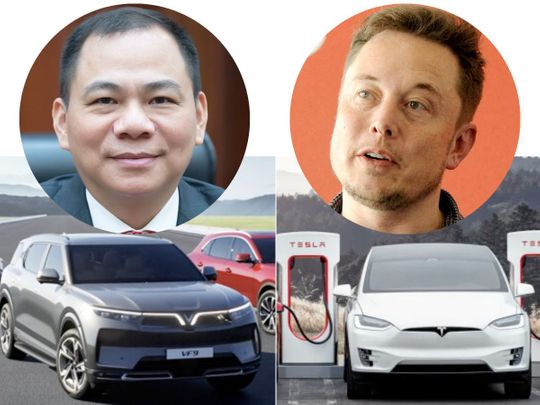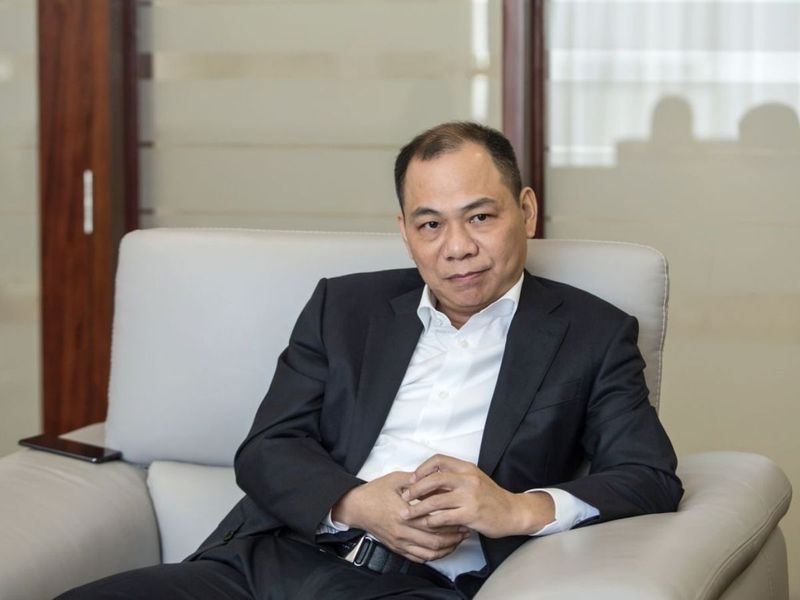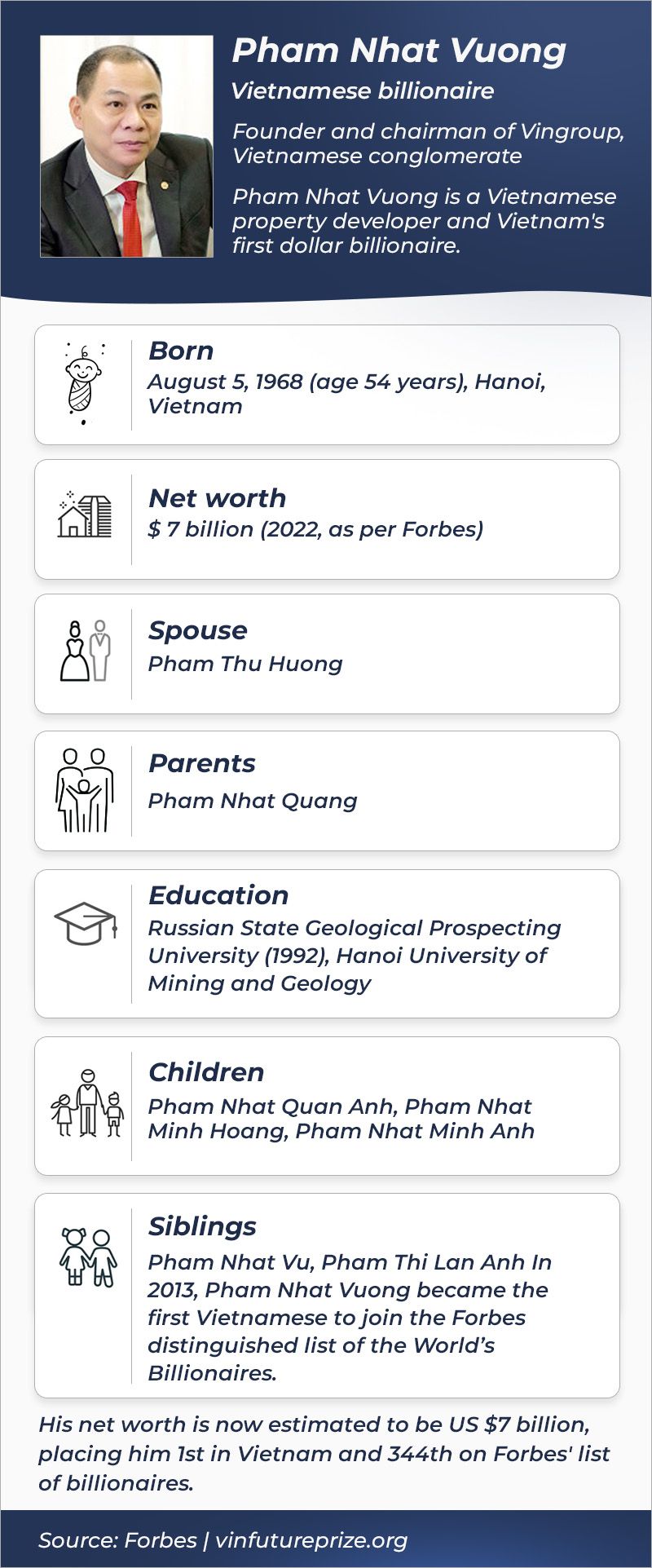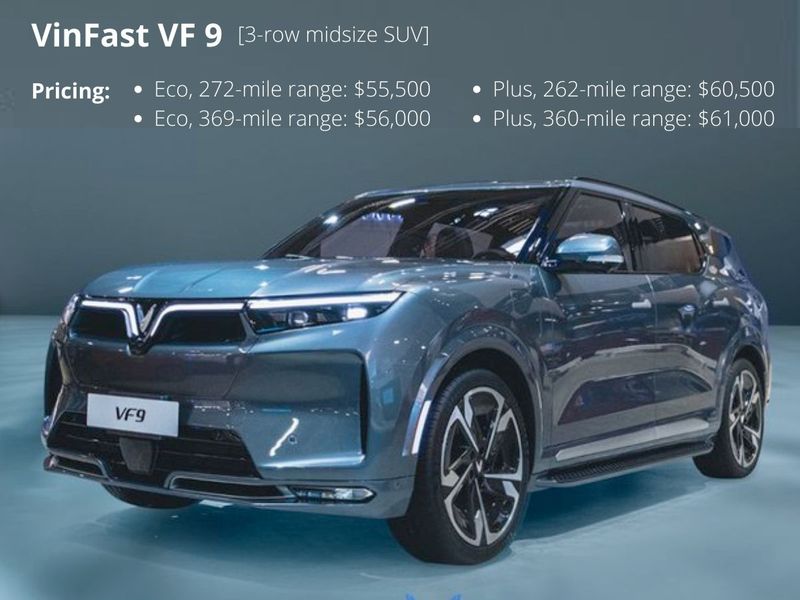
Highlights
- Billionaire Pham Nhat Vuong's VinFast is building a $4-billion EV factory in North Carolina, hoping to sell cars to Americans.
- Many dismiss the ambition as an uphill battle.
- This (under)estimation jumps the gun on consumer preferences, and may be ignoring the "cool" stuff his VF series of electric vehicles offer.
Ever heard about VinFast? Perhaps not. Or perhaps you’re only vaguely aware of the company.
VinFast wants to be the Tesla of Asia — while competing with Elon Musk’s electric vehicle maker (EV) in America. It recently opened dealerships in California for units made in Vietnam, even as it starts to build a $4-billion factory in North Carolina.
VinFast is a new, upcoming EV maker with loads of new ideas and functionality (i.e. car-home integration, zippy user interface and infotainment system). Its vision and innovations could drive the industry standards as a whole.
Billionaire backer
The person behind it: billionaire Pham Nhat Vuong, whose net worth estimated at about $7 billion, as per Forbes. With his bold vision, he’s setting himself on a collision course with Elon Musk of Tesla.
Here’s what we know about Vuong, so far.
Who is Pham Nhat Vuong?
Vuong, 54, is currently the richest man in Vietnam. He is the founder and chair of the VinGroup.
In 1993, after graduating from the Moscow Geological Prospecting Institute in Russia, Vuong launched his first business — a restaurant in Ukraine — funded by money borrowed from friends and family.
He started producing and selling instant noodles. Shortly afterwards, he founded Technocom, becoming a market leader in dehydrated culinary products in Ukraine.
Technocom is the predecessor of Vingroup, a pioneer in Vietnam's food and beverage industry with brand of instant noodles called “Mivina”.
Throughout the 1990s, Vuong’s established a strong foothold in Ukraine under Technocom, providing thousands of jobs. In 2002, Vuong began investing in Vietnam. VinGroup today is the southeast Asian country’s biggest developer.
When did Vuong hit Forbes’ billionaires’ list?
In 2013, Vuong became the first Vietnamese to join the Forbes’ list of the billionaires. Currently, his net worth is estimated to be $7 billion, placing 344th on Forbes' list of billionaires, and on top of Vietnam’s richest.

Vingroup is now investing in cars, with a $5-billion plant in Vietnam, and a massive EV factory in the US on the way, a move that was not left unnoticed by US President Joe Biden.
In March, VinFast announced it will build a $4-billion EV and battery manufacturing facility in North Carolina, and create more than 7,000 jobs.
65,000
global reservations since January for the VinFast VF 8 and VinFast VF 9 SUVs, according to company executivesVinFast started building cars (internal combustion engines) only in 2019, and is a newcomer in EVs. It's set to compete in a tough market already dominated by Elon Musk’s Tesla. It has also filed for an initial public offering this year to raise its international stature, as well as financing.
In 2020, it sold about 30,000 vehicles in 2020, and more than 45,000 units in 2021.
It is producing EVs produced at its factory in the northern port city of Haiphong to domestic customers.
VinFast believes it can win over US and other overseas customers by offering top-quality vehicles with high safety standards and advanced technology.
VinFast plans to open a total of 35 California showrooms and service centres.
California regulators have granted VinFast a license to test autonomous vehicles on public streets.

What are VinFast's prospects in the US?
VinFast is a newcomer in a country known for its centuries-old carmaking industry. Some analysts see an uphill battle for the Vietnamese start-up, even as big legacy carmakers like Ford and GM have been spending billions on electric cars. But there's a confluence of factors that could allow VinFast to fill in the gaps for mass-market EV.
[1] A huge unmet demand for EVs as evidenced by hundreds of thousands of "pre-orders" of certain EVs ahead of initial productions (more than 200,000 for the Ford F150 Lightning, and 1.5 million for the Tesla Cybertruck).
[2] A fast-paced development in software to run EVs, effectively computers-on-wheels.
[3] Strong push for EVs by various governments, now led by the US. The Inflation Reduction Act, signed by US President Joe Biden on August 16, 2022, sweeps through a whole gamut of the trillion-dollar energy sector value chain, essentially linking the drive towards EVs as an antidote to inflation.
It’s an ambitious, “convergence” legislation with specific targets, all new-energy and clean-tech related:
- 120,000 wind turbines
- 950 million solar panels
- 2,300 grid-scale battery plants
- Renewables in rural electric coops serving 42 million people
- Boost the use of electric buses.
- Boost EV and chip manufacturing, while creating jobs.
The US government, too, has announced a plan to replace its fleet of about 600,000 internal combustion engine (ICE) vehicles with battery-powered ones.
VinAI and the research institute are developing autopilot features for cars planned for the US market in 2022.
Where will VinFast build its US factory?
VinFast's manufacturing facility will be built at the Triangle Innovation Point in Chatham County, North Carolina.
What’s the latest on funding this project?
As of July 22, 2022, VinGroup has so far plowed $6.6 billion into VinFast. The company has put together a team headhunted from firms like Ford, Renault, GM, and BMW.
Bold move: $7,500 discount|rebate
After VinFast announced plans to invest in an EV factory in the US, Congress announced it is making changes to the $7,500 federal EV tax credit — i.e. making it much harder for certain buyers to get a tax deduction.
The two major changes were unveiled:
[1] that the tax credit will become means-tested (i.e., households that make more than a certain amount don’t qualify);
[2] the tax credit is capped based on sticker-price (i.e. cars over $40,000 and SUVs and trucks with a slightly higher limit).
That means — up to 70% of today’s EV would not be eligible for a credit, according to a Reuters report. VinFast’s response took it a step further. It promised to give $7,500 discount/rebate to buyers, despite the changed rules.
It’s a bold marketing move. While other carmakers have scrambled to figure out how to react, VinFast took a step further: people who made “pre-orders” who are no longer eligible for the tax rebate, will get a $7,500 discount on the car instead.
VinFast's 10-year warranty
VinFast’s ambition and size all point to a sign: disruption of transport with batteries, AI and robots. VinFast offers a 10-year | 125,000-mile warranty comes from what appears to be a well-thought out plan that considers developments in battery technology.
Here’s a look into its Vietnam plant:
Upsides of Vuong's VinFast:
Some of VinFast’s tech solutions helping it stand out:
Smart EVs:
A computer-on-wheels driven by AI is VinFast’s ultimate goal. Its “Traffic Jam Assist” | “Highway Assist” currently is not fully automated; it requires active driver supervision and the driver must be able to take over control of the vehicle at any moment. It’s an AI-driver-in-training, similar to Tesla’s “Full Self Driving” solution.
Robotics:
Its Vietnam factory employs more than 1,000 robots, welding the complete car bodies together in its $5 billion factory in Haiphong, Vietnam.
Ambition:
Its current production capacity is 250,000 EVs per year, but it seeks to ramp up production to 500,000 EVs per year.
In-car tech package:
From voice-activate commands and content streaming, to online shopping, over-the-air updates and home integration: (i.e. lock/unlock garage door, set AC temp, open lights) — these are currently being dangled to customers as standard on all VinFast vehicles.

Rave reviews:
VinFast has generated rave reviews from some of the most influential YouTubers, including Fully Charged, Supercar Blondie and Nas Daily. It's extolled for its attractive Italian design, standard AWD and a decent expected range of 292 miles | 469 km) for the VF 8 (90 kWh battery pack made from Samsung).
VinFast EVS had been described invariably as “cool”, “more-than-capable” (especially for dual-motor models), and “erred on the side of being smooth”, “unexpected, above and beyond what they needed to do”, among some superlatives. It would be interesting what auto engineering guru Sandy Munro would say after tearing a VinFast EV down.
Leadership:
The company is driven by Vuong, a visionary businessman who, in 21 months, turned a swamp in Vietnam into a 335-hectare state-of-the-art factory.
[VinFast plans to sell cars but lease batteries. Buyers can choose from two lease plans. Because EV batteries degrade over time, VinFast will replace a leased battery — for free — if it slips below 70% of its capacity.]
Downsides to VinFast

Brand value:
It’s made from a country that never really made cars before. Building brand recognition in the US is seen is an uphill battle. Delighting consumers with a disparate technology into a seamless, durable package is an on-going challenge.
Multiple unknowns:
For a consumer to try something new, to buy a VinFast vehicle in one of the world’s most competitive US car markets is a huge hurdle for consumers to jump over.
Besides the lack of reputation, its battery lease plan is also a bit confusing. In the US, it's only lavailable only in California (for now).
What did Elon Musk say about making affordable EVs?
EVs are a whole new world of manufacturing and software development where both legacy automakers and newcomers face an unprecedented challenge, Tesla CEO Elon Musk said earlier: “It's insanely difficult to reach volume production at affordable unit cost.”
VinFast, which started building petrol cars only in 2019, plans to transition to all-EV production starting later this year (2022).
Will VinFast succeed?
Even if the risk of failure for VinFast is “high”, Vuong has already made his point with cars that are both "cool" and compelling. With Tesla, Elon Musk proved an EV-driven future is possible, and that, too, in a country that never meaningfully mass-produced one until 2008 (with the first-generation Roadster). Whether or not VinFast succeeds in its US push from November (2022), only time with tell.



